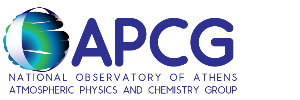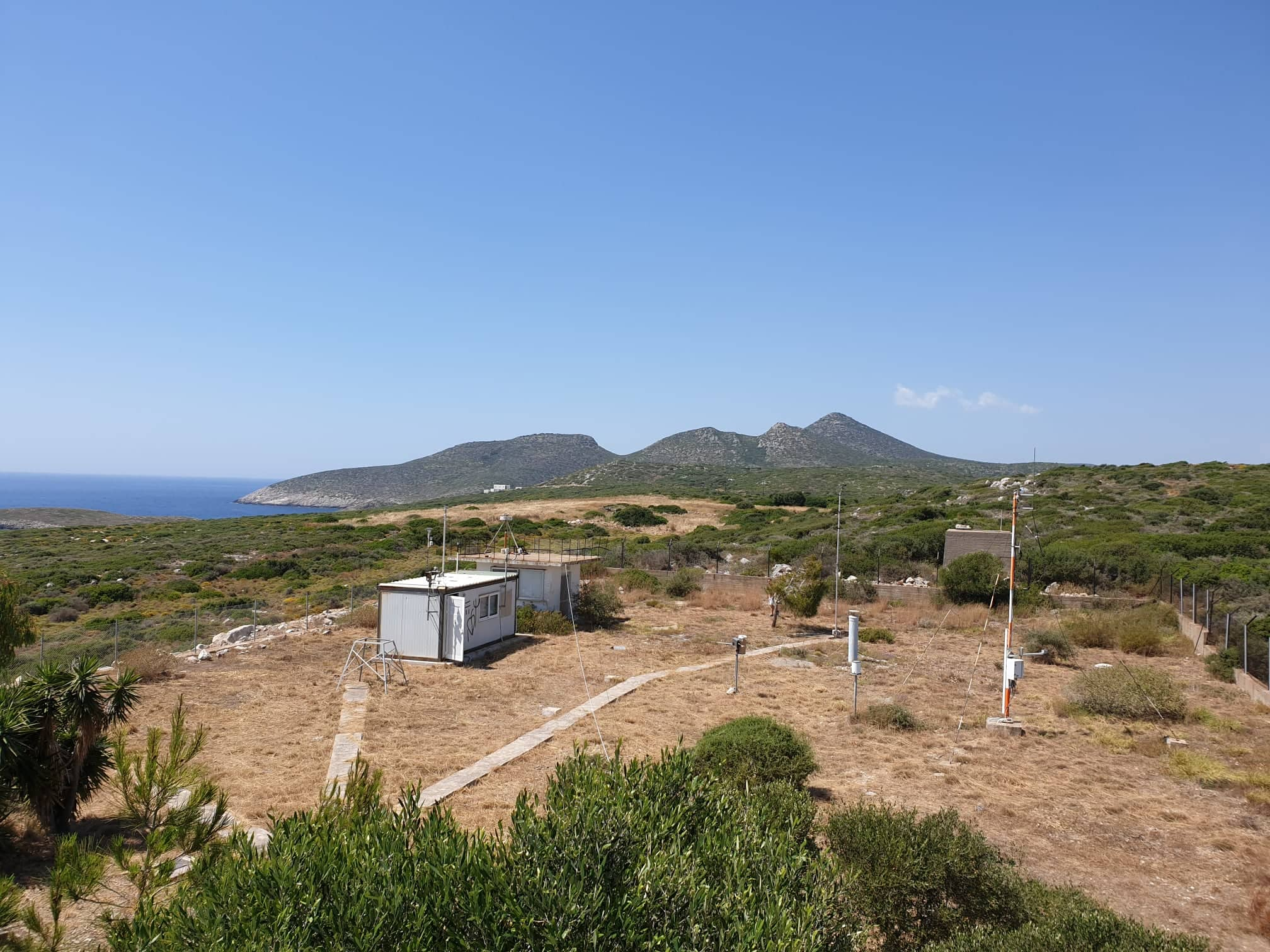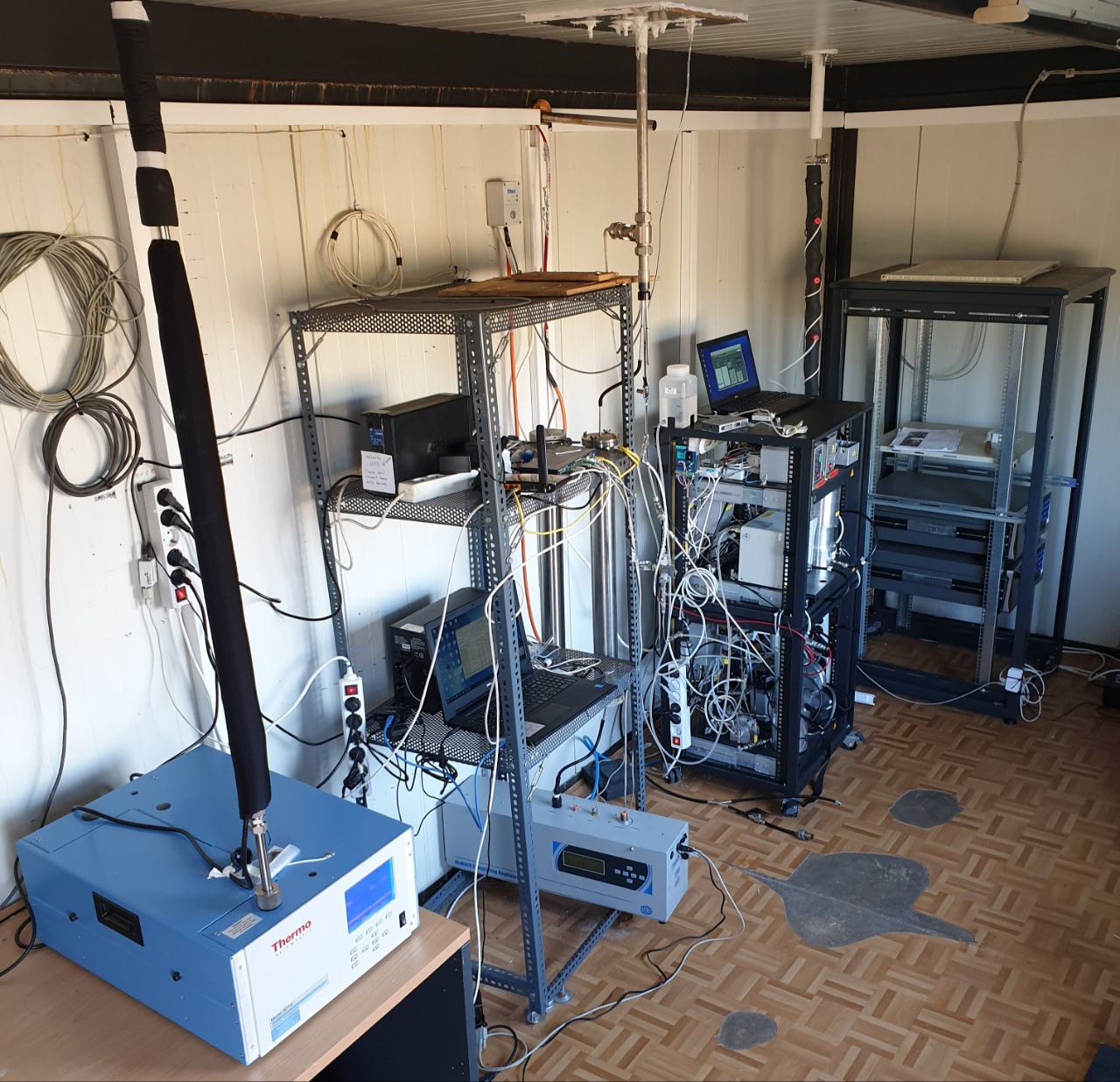The Atmospheric Chemistry Laboratory (ACL) of the National Observatory of Athens (NOA) was founded in 1996 by the Institute for Environmental Research and Sustainable Development (IERSD), one of NOA’s three institutes. ACL/NOA is located at the IERSD’s premises in P. Penteli. In 2005, the Laboratory upgraded its existing infrastructure, in order to be able to provide chemical analysis and air pollutant measurement services, with emphasis on hazardous for public health chemical compounds and species that are harmful to the environment. The immediate objective of ACL/NOA is the provision of high quality services for measuring atmospheric pollutants, in order to meet the demands of Greek society, state and private bodies, for sustainable economic and technological development, coupled with environmental and public health protection. ACL/NOA participates in national and international research projects, conducting both basic and applied research, among others within the fields of Atmospheric Chemistry and Physics and Air Quality. The laboratory equipment includes a variety of analytical instruments for chromatographic and spectroscopic applications, as well as auxiliary equipment and sampling devices. Gravimetric filter measurements for particulate matter (PM) concentrations are conducted in a controlled weighing room. The oxidative potential (OP) of water soluble ambient aerosols is determined by a state of the art semi-automatic analyzer developed in collaboration with the Georgia Institute of Technology, using the Dithiothreitol (DTT) assay. Modification of the system can also provide the absorption of brown carbon (BrC) of water soluble aerosol.
Thissio Air Monitoring Station (Thissio AMS)
The Thissio Air Monitoring Station (Thissio AMS), operating since 2013, is located at the central premises of the National Observatory of Athens, in the historical center of the city (Thissio area, 37.97°N, 23.72° E, 105 m a.s.l.), overlooking the Attica basin from approximately 50m above the mean city level.
The location, on the top of the hill of Nymphs, is ideal for urban background air quality conditions characterization, since the station is located close to the city center and serves as a receptor point of aerosols from various urban and regional sources. It is surrounded by a pedestrian zone, at a moderately populated residential area and the Filopappou (108 m a.s.l) and Acropolis hills (150 m a.s.l), located 500m and 800m away, respectively. There are no major roads within a radius of 500 m.
AMS is part of the PANhellenic infrastructure for Atmospheric Composition and climatE chAnge (PANACEA) National Research Infrastructure (RI) and the Aerosols, Clouds and Trace gases ACTRIS pan-European RI. It also operated infrastructure for monitoring greenhouse gases levels within the frame of the Integrated Carbon Observation System (ICOS) pan-European RI. It is organized and operates according to the integrated strategic plan of the RIs, aiming at high quality and resolution measurements for the provision of near real time information on urban air quality to the citizens, the state and private entities.
The main operation of the station is to monitor atmospheric composition changes and the air quality of the urban environment. This includes, among others, the study of aerosol chemical composition and physical and optical properties, in order to investigate their sources within the urban environment of Athens, their production and transport processes over the Eastern Mediterranean, their climatic role and impacts on health, ecosystems and monument building materials.
Thissio AMS also operates as a hub for highly specialized atmospheric measurements, offering transnational access to interested scientists or students and hosting experimental campaigns, indicatively: (a) monitoring of wintertime smog events, since 2014; (b) wood burning targeted Airborne Unmanned Aerial Vehicle (UAV) observations in Athens, ACTRIS JRA1 campaign (winter 2015-2016); (c) monitoring of the health-related, aerosol oxidative potential, since 2016, (d) climate-relevant measurements (Cloud Condensation Nuclei, 2017-2018); (e) PANACEA seasonal campaigns (2019-2020); (f) evaluation of automated Total Carbon analyzer by Magee Scientific (2019-2021); evaluation and calibration of low/medium cost sensors by intercomparison with reference instruments (2019-2021).
The infrastructure of the station has been continuously upgraded and is currently equipped with specialized on line, high-resolution analyzers for: major gaseous (CO, NO, NO2, SO2, O3) and particulate pollutants (PM1, PM2.5, PM10, BC and its BCff-BCwb fractions), aerosol absorption, scattering and number size distribution, fine aerosol non-refractory chemical speciation (Cl-, NO3-, SO42-, NH4+, Org in PM1) and greenhouse gases (CH4, CO, CO2). At the end of 2021, an automatic gas chromatograph was also installed for the determination of non-methane hydrocarbons with 6 to 12 carbon atoms.
High and low volume samplers for different size fractions (PM2.5 and/or PM10) are utilized on a 24-hours basis (or 12-hours intervals during intensive campaigns) and filter samples are analyzed on a routine basis for the determination of the levels of anions (e.g. Cl-, NO3-, SO42-), cations (K+, Na+, Ca2+, Mg2+, NH4+), elemental and organic carbon (OC and EC) and oxidative potential of aerosols (OP) as well, whereas trace and heavy metals (e.g. Cu, Fe, Pb), brown carbon (BrC) and organic compounds (e.g. levoglucosan, galactosan, mannosan, Polycyclic Aromatic Hydrocarbons and Quinones (PAHs and PAQs)) are further investigated depending on research priorities and needs.
Campaign-based measurements of the ΡΜ1 ionic composition, gaseous acidic compounds such as H2SO4, HNO3 and HCl, as well as for non-methane hydrocarbons with 2-12 carbon atoms have been conducted in Thissio AMS. The infrastructure is further supported by unmanned aerial systems, carrying sensor-based monitors for targeted recording of atmospheric parameters (e.g. temperature, humidity), black carbon and particle size distributions aloft. The results of the measurements were integrated in scientific studies, producing a large number of announcements in conferences and publications in journals with peer review system over the last years.
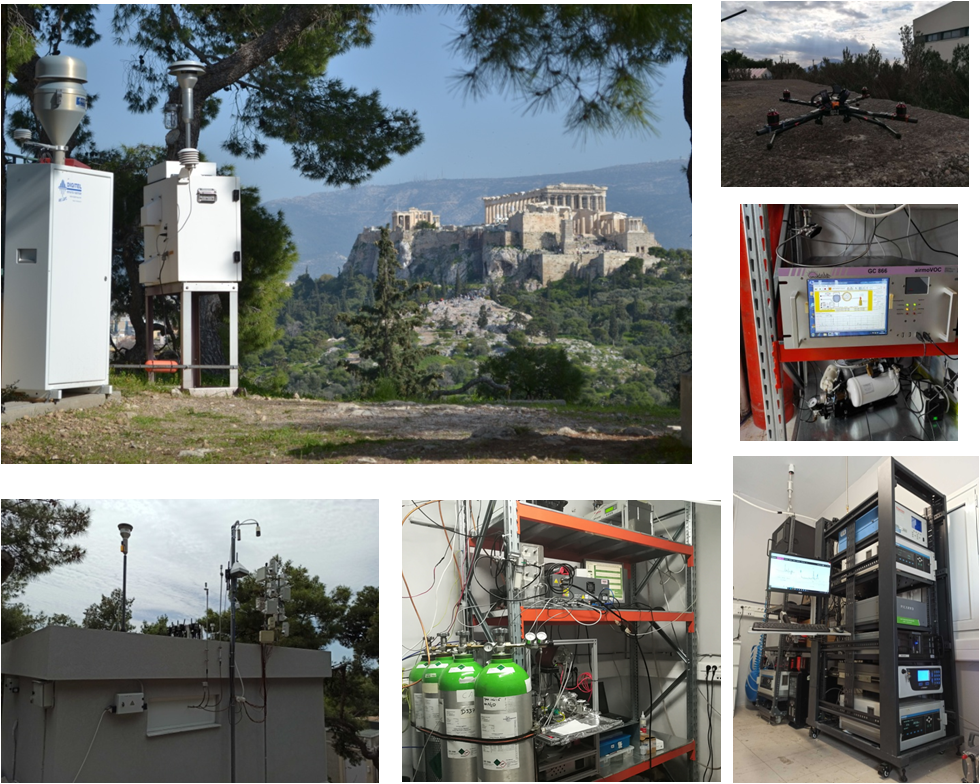
The following instruments are in continuous operation in the Thissio AMS:
|
Pollutant/Property |
Equipment |
|
Carbon Monoxide (CO) |
Analyzer APMA-360, Horiba Ltd. |
|
Nitrogen Oxides (ΝΟx) |
Serinus 40, ACOEM Ecotech |
|
Nitrogen Oxides (ΝΟx) |
Analyzer APNA-360, Horiba Ltd** |
|
Sulphur Dioxide (SO2)* |
Analyzer APSA-360, Horiba Ltd. |
|
Ozone (Ο3) |
Analyzer 49-i, Thermo Scientific |
|
Greenhouse Gases (GHGs; CO2, CH4, H2O) |
Analyzer G2301, Picarro Inc |
|
Volatile Organic Compounds (BTEX, C6-C12) |
Auto GC-FID, GC 866 airmoVOC, AIRMOTEC A.G. (Chromatotec Group) |
|
Particulate Matter PM2.5 |
Beta gauge particulate monitor 5014i, Thermo Fisher Scientific Inc. |
|
Particulate Matter PM10** |
Beta gauge particulate monitor FH 62 I-R, Eberline |
|
Particulate Matter PM1, PM2.5,PM10 |
Μodel 11-D, Grimm Aerosol Technik |
|
Black Carbon (ΒC) – Aerosol Absorption |
Aethalometer 7-λ, Model ΑΕ33, Magee Scientific |
|
Black Carbon, ΒC* |
5012 Multi Angle Absorption Photometer MAAP, Thermo Scientific |
|
Aerosol Scattering |
Integrating Nephelometer model 3563, TSI |
|
Aerosol number size distribution |
Model 3034 Scanning Mobility Particle Sizer-SMPS, TSI |
|
Particle Number Concentration |
Model 3010 Condensation Particle Counter, TSI Inc. |
|
Chemical composition of non-refractory submicron aerosol (Organics, Cl-, NO3-, SO42- και NH4+) |
Aerosol Chemical Speciation Monitor-ACSM, Aerodyne Inc. |
|
ΡΜ1 ionic composition (cations)** |
Particle-Into-Liquid-Sampler - Ion Chromatograph, PILS - IC, Metrohm – Dionex |
|
Sequential low volume aerosol sampler (ΡΜ2.5, ΡΜ2.5-10)** |
Dichotomous Partisol – Plus, Model 2025 Sequential Air Sampler, ThermoScientific |
|
Sequential low volume aerosol sampler (ΡΜ2.5 or ΡΜ10) |
Sampler LVS 3.1 – PNS 15, Derenda |
|
High volume aerosol sampler (ΡΜ2.5) |
Digitel DH-77 |
|
Datalogger |
Congrego v.4.0.1, Ecotech |
|
* Equipment also used in the Mobile Air Quality Monitoring Station **Equipment used in past long-term measurements |
|
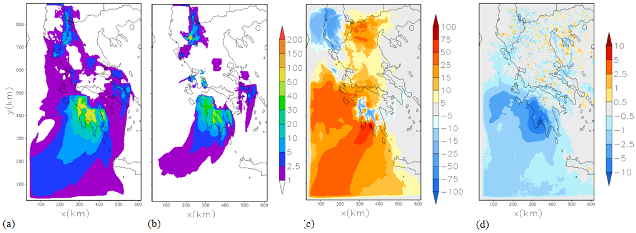
Spatial distribution of: (a) average concentrations (μg m-3) of total carbon (TC), (b) average concentrations (μg m-3) of nitric monoxide and dioxide (NOx), c) average concentrations (ppb) of total ozone column (O3) and d) direct effect of aerosol on total surface radiation (W m-2), during the summer 2007 wildfire event in Peloponnese, Greece (COSMO-ART applications during 22 August – 02 September, Athanasopoulou et al., 2014).
Members of the APCG group are involved with atmospheric model applications. In particular, they performe gas and aerosols simulations with the regional atmospheric model COSMO-ART. COSMO-ART is a regional atmospheric model (ART stands for Aerosols and Reactive Trace gases), developed by the ‘Aerosols, Trace Gases and Climate Processes’ Group of the Institute for Troposphere Research, Karlsruhe Institute of Technology (KIT), Germany (Vogel et al., 2009). The model is online-coupled to the COSMO regional numerical weather prediction and climate model (Baldauf et al., 2011) of the German Weather Service (DWD). The processes of emissions, gas and aerosol chemistry, coagulation, condensation dry deposition, sedimentation and washout are taken into account.
COSMO-ART applications of APCG group use the anthropogenic emission database TNO-MACCII, processed by EMPA (Switzerland) under an MoU with NOA. Meteorological data and support is provided by the German Weather service (DWD). Meteorologically-affected emissions (ssa-salt, dessert dust and biogenic emission) are online-coupled to the model system (Vogel et al., 1995; 2006; 2009). The online coupling allows for feedbacks of aerosols on temperature, radiation and cloud condensation nuclei (Vogel et al., 2009; Bangert et al., 2011; Bangert et al., 2012; Athanasopoulou et al., 2012).
COSMO-ART applications of APCG group currently cover the greater area of Greece, centered at the city of Athens. Applications are supported by computational time granted from the Greek Research & Technology Network (GRNET) in the National HPC facility – ARIS. Parallel support from the HPC KIT system exists. The model domain chosen for APCG applications is the greater area of Greece, centered on the city of Athens. The horizontal resolution is 0.025 deg. and the vertical extend of the domain reaches ~20 km (60 layers). Up to present, APCG applications cover 3 selected cases: (a) the extreme wildfires of 2007 (Athanasopoulou et al., 2014), (b) the smog episodes of winter 2013-’14 (Athanasopoulou et al., 2016, in prep), and (c) September 2015, during the first citizen observatory campaign in Greece (iSPEX campaign; Athanasopoulou et al., 2016, accepted for publication in Springer).
|
"We perform earth system, atmospheric, chemical transport and radiative transfer modeling" |
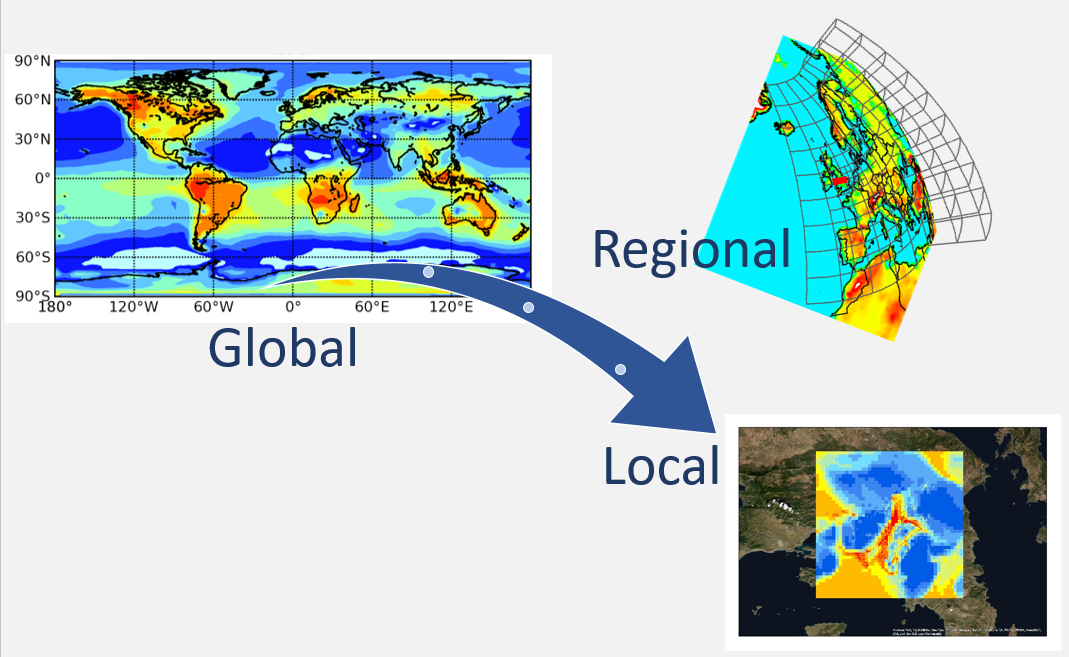 |
The modelling team of APCG has developed computational facilities specialized for usage in atmospheric modelling and handling of big data related to that. This infrastructure currently includes one Dell R540 Rack Server (Dell 0VC7DK motherboard, 2 x Intel Xeon Gold 5218 CPU - 32 cores total, 201 GB RAM DDR4, 8TB HDDDell RAID hard disc, Linux Centos). Further expansion and upgrades have already been scheduled to address the increasing needs of the group.
Modelling activities are also supported by annual computational grants received by the Greek Research and Technology Network (GRNET) for computational access at the National HPC facility – ARIS.
The main models/model systems (i.e. software), operated systematically by the group, as part of the infrastructure,are listed below:
- The European community Earth-System Model EC-Earth (http://www.ec-earth.org) which is a state-of-the art coupled climate model, developed and used for climate predictions and projections, by a European consortium of more than 20 operational and research institutions, including APCG group from NOA-IERSD. EC-Earth consists of an atmospheric general circulation model (GCM) based on the ECMWF Integrated Forecast System (IFS) model, with the H-TESSEL land-surface scheme and an ocean GCM from the Nucleus, for European Modeling of the Ocean (NEMO), with the Louvain-la-Neuve sea ice model (LIM). APCG is part of the development of components of TM5 (Krol et al., 2005), the global CTM, integrated into EC-Earth and it is used for simulating the atmospheric chemistry and transport of reactive gases and aerosols. EC-Earth3 also contains an advanced representation of the dust-iron cycle, which allows quantification of the contribution of different sources (dust, biomass burning, and anthropogenic aerosols) and processes (acidic and oxalate processing) to the soluble iron deposition into the ocean, as recently developed and published by our group (i.e., Myriokefalitakis et al., 2021).EC-Earth is an important modelling component of the DOMOS and ADIOS research projects of the APCG group, cited here.
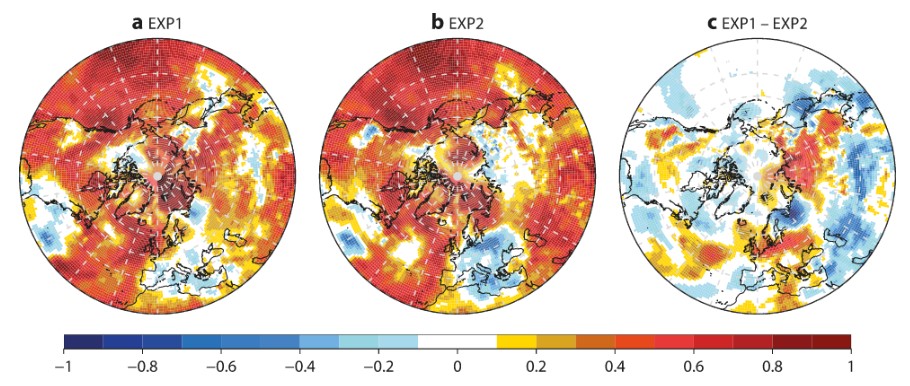
- COSMO-ART is a regional atmospheric model which couples online meteorology, chemistry, and aerosol dynamics (Fig. 2). It is the operational numerical weather prediction model of the German and other European weather services (Baldauf et al., 2011)a modified version CCLM (Rockel et al., 2008) of which, is used as a regional climate model. ART (Aerosols and Reactive Trace gases) is the chemistry extension of COSMO. Detailed descriptions of the model, the physic-chemical characteristics of the aerosol modes and the parameterizations of interactions of aerosols with radiation, temperature, cloud and ice condensation nuclei (CCN and IN), are given in Vogel et al. (2009), Bangert et al. (2011; 2012) and Rieger et al. (2014). The model domain chosen for the research activities of the APCG group is the extended area of Greece, centered in Athens. The setup of the model applications is given in Athanasopoulou et al (2017), largely based on the pilot study of the COSMO-ART application over the same domain (Athanasopoulou et al., 2014). Both references are given in the publication list of APCG, here. Computational time and space are systematically granted by the GRNET (HPC ARIS). COSMO-ART has been employed in the research project THESPIA 2, cited here.
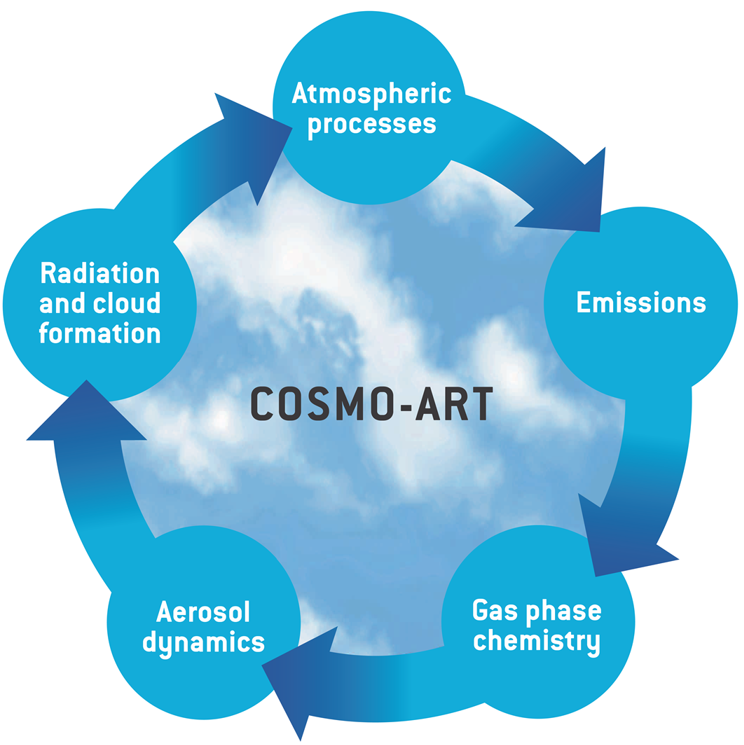
- The model system to simulate atmospheric conditions at the local scale is composed of the NWP model WRF and of the CTM EPISODE-CItyChem. WRF is a mesoscale numerical weather prediction model, which can serve both atmospheric research and operational forecasting needs. It features two dynamical cores, a data assimilation system and software architecture supporting parallel computation and system extensibility. For the atmospheric applications of the APCG group, the WRF model performs telescoping nesting, with the innermost domain over Athens (or any city of interest) and spatial resolution of 1 km. EPISODE-CityChem (fig. 3), is a Chemistry Transport Model to enable chemistry/transport simulations of reactive pollutants at the city scale. EPISODE is a Eulerian dispersion model developed at the Norwegian Institute for Air Research (NILU) appropriate for air quality studies at the local scale. The CityChem extension, developed at the Helmholtz-Zentrum (HZG), is designed for treating complex atmospheric chemistry in urban areas and improved representation of the near-field dispersion (Karl et al., 2019). The model is capable of simulating atmospheric chemistry in 1 km, reaching the 100 m spatial resolution, over and downstream industrial (points) and road network (lines) emissions. The WRF/CityChem model system is been used in several research projects where APCG participates, such as SMURBS, e-shape, RI-URBANS, EIFFEL, ARSINOE, all sited here. The configuration, application and results of EPISODE-CityChem model applications for Athens and Hamburg are given in the open access scientific article by Ramacher et al., 2021. Reference to be found here.

- Supplementary, the group operates the TAPM atmospheric system, which simulates atmospheric conditions at the local scale, using a simpler but computationally more efficient approach. TAPM is a prognostic meteorology-dispersion model, capable of predicting the flows important to local-scale air pollution, utilizing a background of larger-scale meteorology provided by synoptic analyses. The model includes a chemistry mode with sulfur and fine particle chemistry (PM10, NOX, NO2, O3, SO2, PM2.5), which is composed of gas-phase photochemical reactions, based on the Generic Reaction Set and gas- and aqueous-phase chemical reactions for SO2 and particles. Wet and dry deposition is also simulated. This tool has enabled the APCG group to work towards identifying the interactions between climate change (climatic scenarios) and future air pollution at the municipality (or 1 by 1 km2) level in the frame of National project ΠΕΣΠΚΑ, and to provide half-year NO2 outputs to compare with MAX-DOAS retrievals (MAX3D project). Both projects can be found in the APCG project list, here.The configuration, application and results of the model applications for Athens are given in the open access scientific article by Grivas et al., 2020 and Gratsea et al., 2021. References to be found here.
- The model system to predict plume dispersion from any (potential) industrial accident is composed by the WRF weather prediction model and FLEXPART Gaussian dispersion model. The meteorological forecast for any area of interest is supported by the GFS global weather predictions. FLEXPART is a Lagrangian transport and dispersion model, suitable for the simulation of a large range of atmospheric transport processes. Apart from transport and turbulent diffusion, it is able to simulate dry and wet deposition, decay, linear chemistry; it can be used in forward or backward mode, with defined sources or in a domain-filling setting. This system (Fig. 4) has been operating to predict plume dispersion from the real industrial accident of Aspropyrgos, as well as from potential accidents at industrial facilities outside the city of Ljubljana (Slovenia), Cork (Ireland) and Ritsona (Greece), in the frame of InfraStress and SMURBS projects, cited here.

- A series of box-modeling tools are applied, built around the Thissio AMS, that can run in various configurations to simulate and study air-quality relevant species (such as O3, CO), the secondary formation of inorganic aerosols (e.g., nitrates, ammonium), the oxidative capacity (i.e., OH and NO3 radicals), and the acidity of particles. The aforementioned box-modeling tools use a number of state-of-the-art submodels, such as the thermodynamic module ISORROPIA, the size-resolved aerosol microphysics module M7, the kinetic preprocessor KPP software environment for solving chemical kinetics, etc.
- To support city scale model applications. The modelling group of APCG has recently co-developed -in constant cooperation with the Chemistry Transport Group of Helmholtz-Zentrum (HZG)-and operates the UrbEm Hybrid Method to Derive High-Resolution Anthropogenic Emissions of air pollutants. UrbEm (Fig. 5) fully covers the emission inventory which is prerequisite for all urban air quality modeling and management efforts and serves as a starting point for such efforts in cities across Europe. The application of the UrbEm approach is realized as a software tool that is completely free of cost and open source distributed via GitHub (https://github.com/martinottopaul/UrbEm). The tool may run on different operating systems on single-core processors and need a minimum of 2 gigabyte RAM. It can be applied to any urban area in Europe and provides methodological homogeneity between different cities. Researchers of the APCG group have already applied the tool for selected pilot European cities, while they are constantly optimizing it to be further applied in more than 10 European cities in the frame of SMURBS, e-shape, RI-URBANS, EIFFEL, ARSINOE, ΠΕΣΠΚΑ, MAX3D projects, cited here. The description, application and results of UrbEm applications for Athens and Hamburg are given in the open access scientific article by Ramacher et al., 2021, reference to be found here.
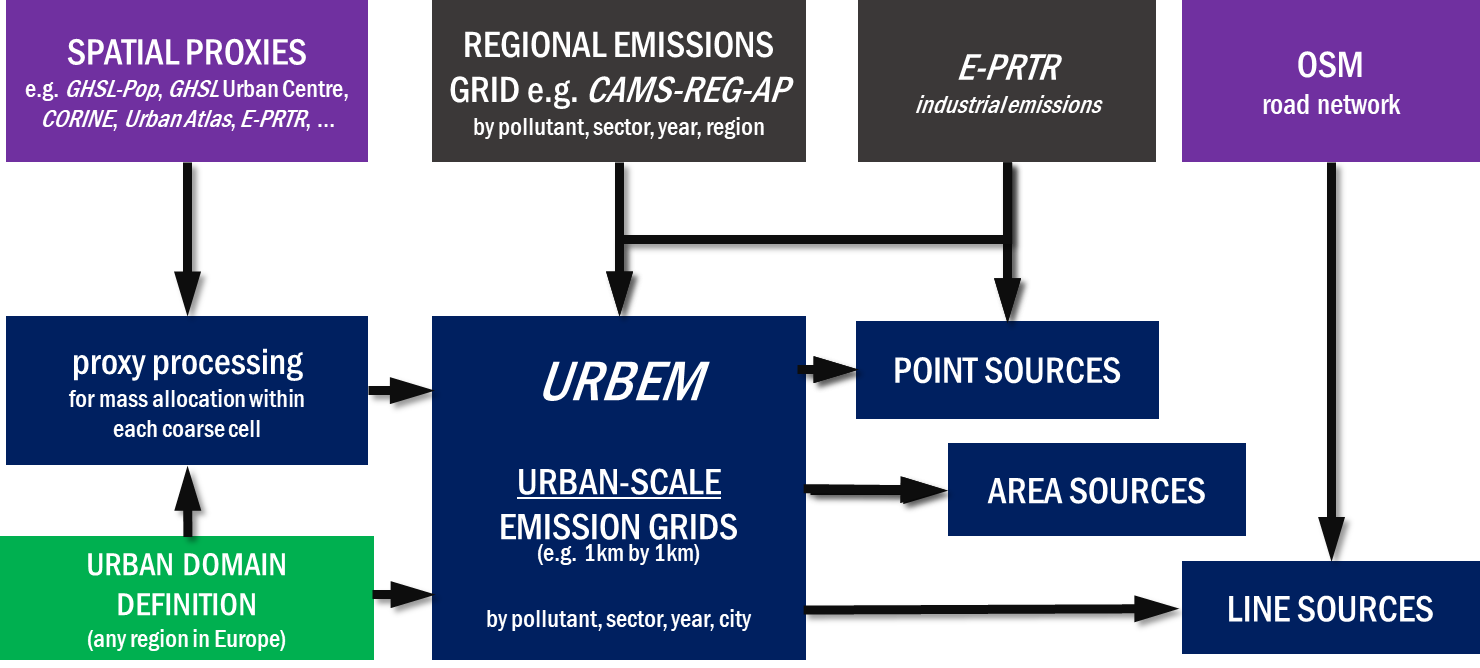
- Renewable energy monitoring, forecasting, management, planning and penetration into society is pursued through dedicated web tools and applications (https://solea.gr/) from the SOLEA part of the APCG group. SOLEA addresses the needs of a variety of public and private sector communities including electricity handling entities and renewable energy producers (fig 6). The operational running in real-time for the European and North Africa domain, exploits a Rack PC, Windows server with CentOS, 32 cores, 64 Gb RAM, 12 Tb RAID10. When advanced, dynamic and large scale applications are performed, using and producing big data for solar energy, the Amazon Web Services, Unix, 256 CPU cores, 24K GPU cores,3Tb RAM, 90 Tb is used. Computational applications include: Radiative Transfer Models (Emde et al., 2016) for the simulation of surface solar radiation and energy; Fast Solar Spectral Radiation architectures, using high performance and distributed computing (Kosmopoulos et al., 2018; 2021) for instant radiative transfer simulations for solar energy related operational products and services; Cloud Motion Vector Analysis for the development of pattern identification and tracking algorithms for short-term forecasting purposes (Kosmopoulos et al., 2020). SOLEA models and services have been employed in the research projects Smurbs, Eiffel, Geo-Cradle and EuroGEO e-shape.

Navarino Environmental Observatory (NEO), a cooperation between Stockholm University, the Academy of Athens and TEMES S.A., is dedicated to research and education on the climate and environment of the Mediterranean region. In this framework NEO researchers in collaboration with the Institute for Environmental Research and Sustainable Development of the National Observatory of Athens (IERSD/NOA) and the National Hellenic Meteorological Service have established an Atmospheric Observation Station at Regional unit of Messinia. The NEO atmospheric monitoring station operates at Methoni, a coastal site at SW Greece (36° 49' 32'' N, 21° 42' 17'' E, 50 m a.s.l.), to track climate change signals and air pollution. It is an important part of a European Network and fills the gap of missing data from this part of Europe.
The role of the site is to maintain long term monitoring of aerosol physical, chemical and optical properties, in an attempt to shed light on the factors that control their levels and variability as well as to discriminate the relevant contribution from long range transport versus local sources, with emphasis on the role of biomass burning (branches burn - oil trees harvest, domestic heating).
|
Panoramic view of the NEO station |
The interior design of the NEO station |
Among the parameters measured are:
- Scattering coefficient at 530 nm monitored by means of a nephelometer (M903, Radiance Research) under a flow of 5 lpm, at five minute resolution. The instrument is coupled with a silica gel dryer to provide measurement in dry conditions.
- Absorption coefficient quantified as a function of Black Carbon (BC) with a single wavelength aethalometer (model AE-16, Magee Scientific) at 880 nm, sampling at 7.5 lpm with five-minute resolution. The aethalometer data are corrected for multiple scattering and shadowing effects according to Weingartner et al (2003).
- Aerosol size distributions in the 0.4-20 μm aerodynamic diameter range monitored by a custom made DMPS (Sweden SU) and an Aerodynamic Particle Sizer (APS-3321, TSI).
- PM10 sampling and chemical composition on campaign basis (summer 2012, winter 2013) and semi continuously (15days/month) since March 2016.
- Gas analyzers: O3, CO
